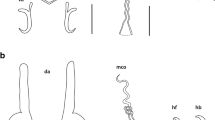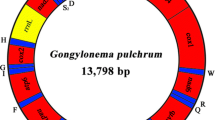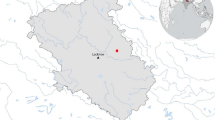Abstract
Metagonimus Katsurada, 1912 is a genus of small intestinal parasites. The genus comprises eight species, primarily from far-eastern Asia, with two exceptions reported from Europe. Metagonimus yokogawai, the most widespread species, is the main agent responsible for the intestinal disease, metagonimiasis, in Japan and some other East Asian countries. On the basis of the ratio of the size of the ventral and oral suckers, Metagonimus has traditionally been morphologically divided into two groups; however, the genus has not been extensively studied using molecular data. To reveal phylogenetic relationships within Metagonimus based on molecular data, we analyzed six of the seven species present in Asia using samples collected in central Japan. Maximum likelihood and Bayesian analyses of a combined 28S ribosomal DNA (rDNA), internal transcribed spacer 2 (ITS2), and mitochondrial cox1 gene sequence dataset separated the six species into two well-supported clades. One clade comprised M. yokogawai, M. takahashii, M. miyatai, and M. hakubaensis, whereas the other consisted of M. otsurui and M. katsuradai. Genetic distances calculated from 28S rDNA and ITS2 nucleotide sequences and a comparison of the predicted amino acid sequences of cox1 gene suggested that M. otsurui and M. katsuradai may have diverged recently. None of the four main morphological characters used to delimit species of Metagonimus (i.e., sucker ratio, positions of the uterus and testes, and distribution of vitelline follicles) was consistent with the distribution of species in the molecular tree.


Similar content being viewed by others
References
Bowles J, McManus DP (1994) Genetic characterization of the Asian Taenia, a newly described taeniid cestode of humans. Am J Trop Med Hyg 50:33–44
Chai JY, Sohn WM, Kim MH, Hong ST, Lee SH (1991) Three morphological types of the genus Metagonimus encysted in the dace, Tribolodon taczanowskii, caught from the Sumjin River. Korean J Parasitol 29:217–225
Chai JY, Han ET, Park YK, Guk SM, Kim JL, Lee SH (2000) High endemicity of Metagonimus yokogawai infection among residents of Samchok-shi, Kangwon-do. Korean J Parasitol 38:33–36
Chai JY, Murrell KD, Lymbery AJ (2005) Fish-borne parasitic zoonoses: status and issues. Int J Parasitol 35:1233–1254
Chai JY, Shin EH, Lee SH, Rim HJ (2009) Foodborne intestinal flukes in Southeast Asia. Korean J Parasitol 47:S69–102
Cunningham CW (1997) Can tree incongruence tests predict when data should be combined? Mol Biol Evol 14:733–740
Doanh PN, Shinohara A, Horii Y, Habe S, Nawa Y, The DT, Le NT (2007) Morphological and molecular identification of two Paragonimus spp., of which metacercariae concurrently found in a land crab, Potamiscus tannanti, collected in Yenbai Province, Vietnam. Parasitol Res 100:1075–1082
Hall TA (2011) BioEdit: an important software for molecular biology. GERF Bull Biosci 2:60–61
Hong NT, Seo BS (1969) Study on Metagonimus yokogawai (Katsurada, 1912) in Korea. 1. On the metacercaria, its distribution in the second intermediate host and development in the final host. Korean J Parasitol 7:129–142
Ito J (1964) Metagonimus and other human heterophyid trematodes. Progr Med Parasitol Jpn 1:315–393
Katsurada F (1912) On a new trematode. Metagonimus yokogawai. Tokyo Iji Shinshi 1796:3483–3489 (in Japanese)
Katsuta I (1932) Studies on the metacercariae of Formosan brackish water fish, 2. On a new species, Metagonimus minutus n. sp. parasitic in Mugil cephalus. Taiwan Iggakai Zasshi 31:26 (in Japanese)
Kim DG, Kim TS, Cho SH, Song HJ, Sohn WM (2006) Heterophyid metacercarial infections in brackish water fishes from Jinju-man (Bay), Kyongsangnam-do, Korea. Korean J Parasitol 44:7–13
Kino K, Suzuki T, Oishi H, Suzuki S, Yamagiwa S, Ishiguro M (2006) Geographical distribution of Metagonimus yokogawai and M. miyatai in Shizuoka Prefecture, Japan, and their site preferences in the sweetfish, Plecoglossus altivelis, and hamsters. Parasitol Int 55:201–206
Kobayashi H (1912) On a new genus of the trematode (a preliminary report). Saikingaku Zasshi 204:780–786 (in Japanese)
Larkin MA, Blackshields G, Brown NP, Chenna R, McGettigan PA, McWilliam H, Valentin F, Wallace IM, Wilm A, Lopez R, Thompson JD, Gibson TJ, Higgins DG (2007) Clustal W and Clustal X version 2.0. Bioinformatics 23:2947–2948
Lee SU, Huh S, Sohn WM, Chai JY (2004) Sequence comparisons of 28S ribosomal DNA and mitochondrial cytochrome c oxidase subunit I of Metagonimus yokogawai, M. takahashii and M. miyatai. Korean J Parasitol 42:129–135
Lockyer AE, Olson PD, Østergaard P, Rollinson D, Johnston DA, Attwood SW, Southgate VR, Horak P, Snyder SD, Le TH, Agatsuma T, McManus DP, Carmichael AC, Naem S, Littlewood DT (2003) The phylogeny of the Schistosomatidae based on three genes with emphasis on the interrelationships of Schistosoma Weinland, 1858. Parasitology 126:203–224
Olson PD, Cribb TH, Tkach VV, Bray RA, Littlewood DTJ (2003) Phylogeny and classification of the Digenea (Platyhelminthes: Trematoda). Int J Parasitol 33:733–755
Ronquist F, Teslenko M, van der Mark P, Ayres DL, Darling A, Höhna S, Larget B, Liu L, Suchard MA, Huelsenbeck JP (2012) MrBayes 3.2: efficient Bayesian phylogenetic inference and model choice across a large model space. Syst Biol 61:539–542
Saito S, Chai JY, Kim KH, Lee SH, Rim HJ (1997) Metagonimus miyatai sp. nov. (Digenea: Heterophyidae), a new intestinal trematode transmitted by freshwater fishes in Japan and Korea. Korean J Parasitol 35:223–232
Shimazu T (1999) Metagonimus hakubaensis sp. n. Digenea, Heterophyidae from Nagano, Japan: morphology and life cycle. Bull Natn Sci Mus Ser A 25:87–99
Shimazu T (2002) Life cycle and morphology of Metagonimus miyatai (Digenea: Heterophyidae) from Nagano, Japan. Parasitol Int 51:271–280
Shimazu T (2003) Morphology of metacercariae and adults of Metagonimus katsuradai Izumi (Digenea, Heterophyidae) from Shiga, Japan. Bull Natn Sci Mus Ser A 29:47–51
Shimazu T, Kino H (2015) Metagonimus yokogawai (Trematoda: Heterophyidae): from discovery to designation of a neotype. Korean J Parasitol 53:627–639
Shimazu T, Urabe M (2002) Morphology and life cycle of Metagonimus otsurui (Digenea, Heterophyidae) from Nara, Japan. Bull Natl Sci Mus Tokyo, Series A 28:21–28
Skov J, Kania PW, Dalsgaard A, Jorgensen TR, Buchmann K (2009) Life cycle stages of heterophyid trematodes in Vietnamese freshwater fishes traced by molecular and morphometric methods. Vet Parasitol 160:66–75
Sohn WM (2009) Fish-borne zoonotic trematode metacercariae in the Republic of Korea. Korean J Parasitol 47:S103–S113
Swofford DL (1998) PAUP: Phylogenetic analysis using parsimony (and other methods), version 4.0. Sinauer. Sunderland, Massachusetts
Tamura K, Stecher G, Peterson D, Filipski A, Kumar S (2013) MEGA 6: molecular evolutionary genetic analysis version 6.0. Mol Biol Evol 30:2725–2729
Thaenkham U, Waikagul J (2008) Molecular phylogenetic relationships of Paragonimus pseudoheterotremus. SE Asian J Trop Med Publ health 39:217–221
Thaenkham U, Dekumyoy P, Komalamisra C, Sato M, Dung do T, Waikagul J (2010) Systematics of the subfamily Haplorchiinae (Trematoda: Heterophyidae), based on nuclear ribosomal DNA genes and ITS2 region. Parasitol Int 59:460–465
Thaenkham U, Blair D, Nawa Y, Waikagul J (2012) Families Opisthorchiidae and Heterophyidae: are they distinct? Parasitol Int 61:90–93
Uppal B, Wadhwa V (2005) Rare case of Metagonimus yokogawai. Ind J Med Microbiol 23:61–62
Xia X (2013) DAMBE5: a comprehensive software package for data analysis in molecular biology and evolution. Mol Biol Evol 30:1720–1728
Yamada SM, Yamada S, Takada H, Hoshiai YC, Yamada S (2008) A case of metagonimiasis complicated with multiple intracerebral hemorrhages and diabetes mellitus. J Nippon Med Sch 75:32–35
Yu YR, Chai JY (2012) Metagonimus. In: Liu D (ed) Molecular detection of human parasitic pathogens. CRC Press (Taylor and Francis Group), Boca Raton, pp 389–398
Yu S-H, Mott KE (1994) Epidemiology and morbidity of food-borne intestinal trematode infections. Trop Dis Bull 91:R125–R152
Acknowledgments
We thank the staff members of the Department of Helminthology, Faculty of Tropical Medicine, Mahidol University, Bangkok, Thailand for their technical support and permission to use its equipment and facilities. We express our thanks to David Blair, College of Marine and Environmental Science, James Cook University, for his valuable comments on this manuscript. We also thank Paul Adams and Glad Rotaru for language corrections of the manuscript. This research was supported by the Thailand Research Fund (TRF), Thailand (grant number MRG5380075) and the Faculty of Tropical Medicine, Mahidol University, Thailand.
Author information
Authors and Affiliations
Corresponding author
Ethics declarations
The hamsters were handled and maintained according to the guidelines provided in the Guide for the Care and Use of Laboratory Animals of Hamamatsu University School of Medicine, Japan (approval nos. 2007085 and 2012012).
Electronic supplementary material
Below is the link to the electronic supplementary material.
ESM 1
(DOC 4281 kb)
Rights and permissions
About this article
Cite this article
Pornruseetairatn, S., Kino, H., Shimazu, T. et al. A molecular phylogeny of Asian species of the genus Metagonimus (Digenea)—small intestinal flukes—based on representative Japanese populations. Parasitol Res 115, 1123–1130 (2016). https://doi.org/10.1007/s00436-015-4843-y
Received:
Accepted:
Published:
Issue Date:
DOI: https://doi.org/10.1007/s00436-015-4843-y




